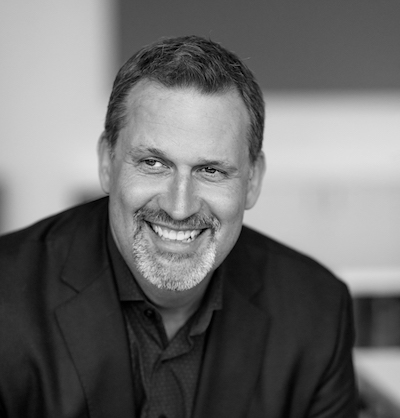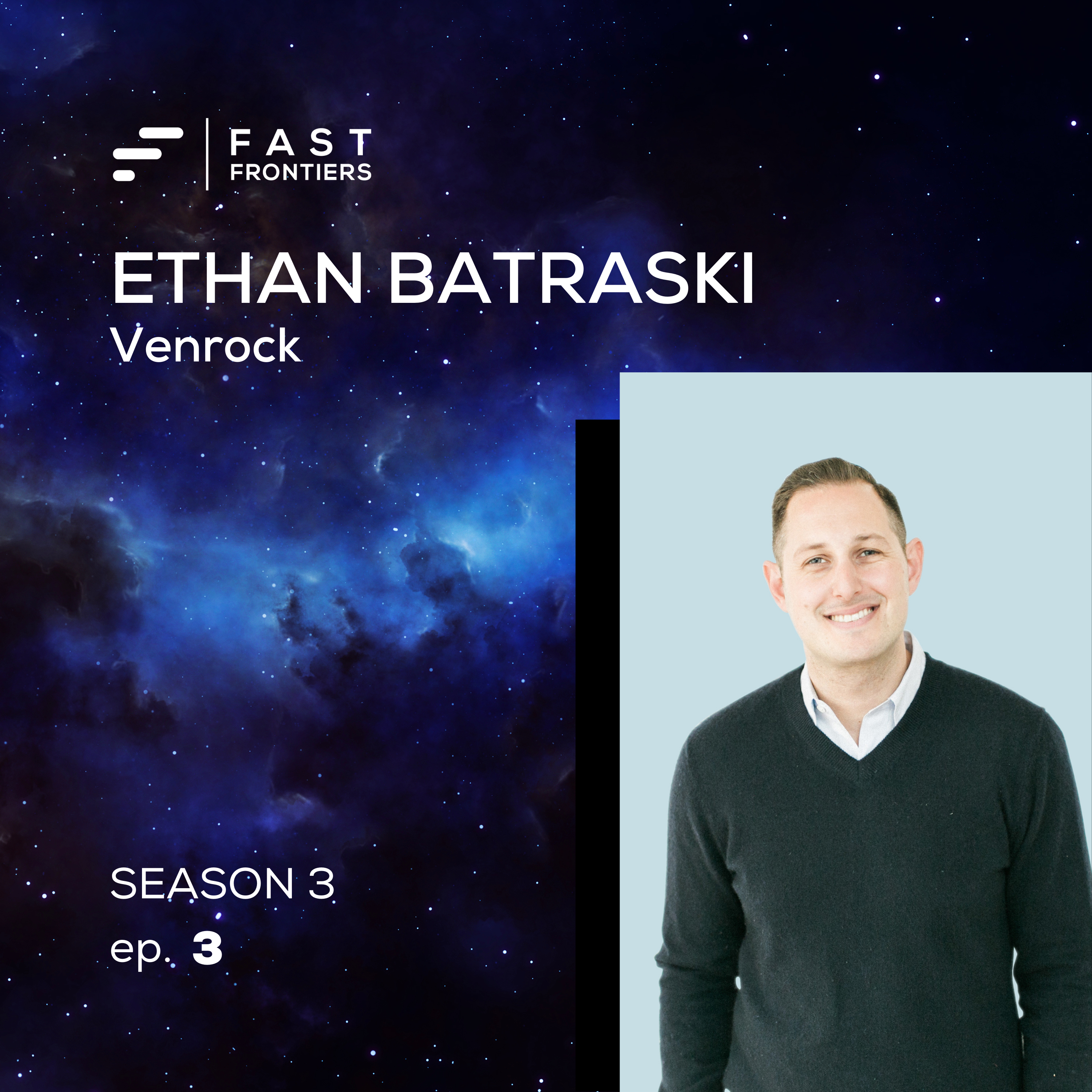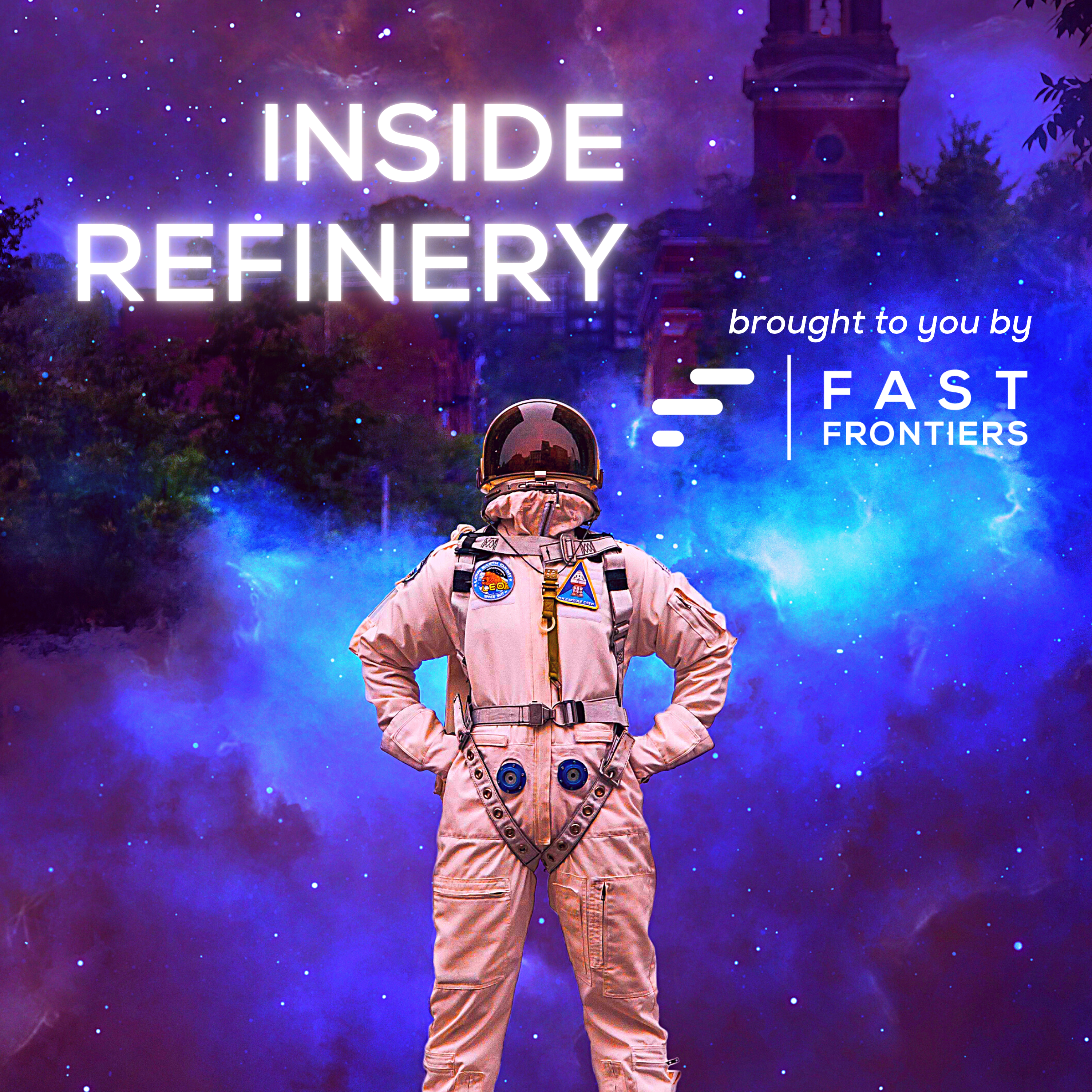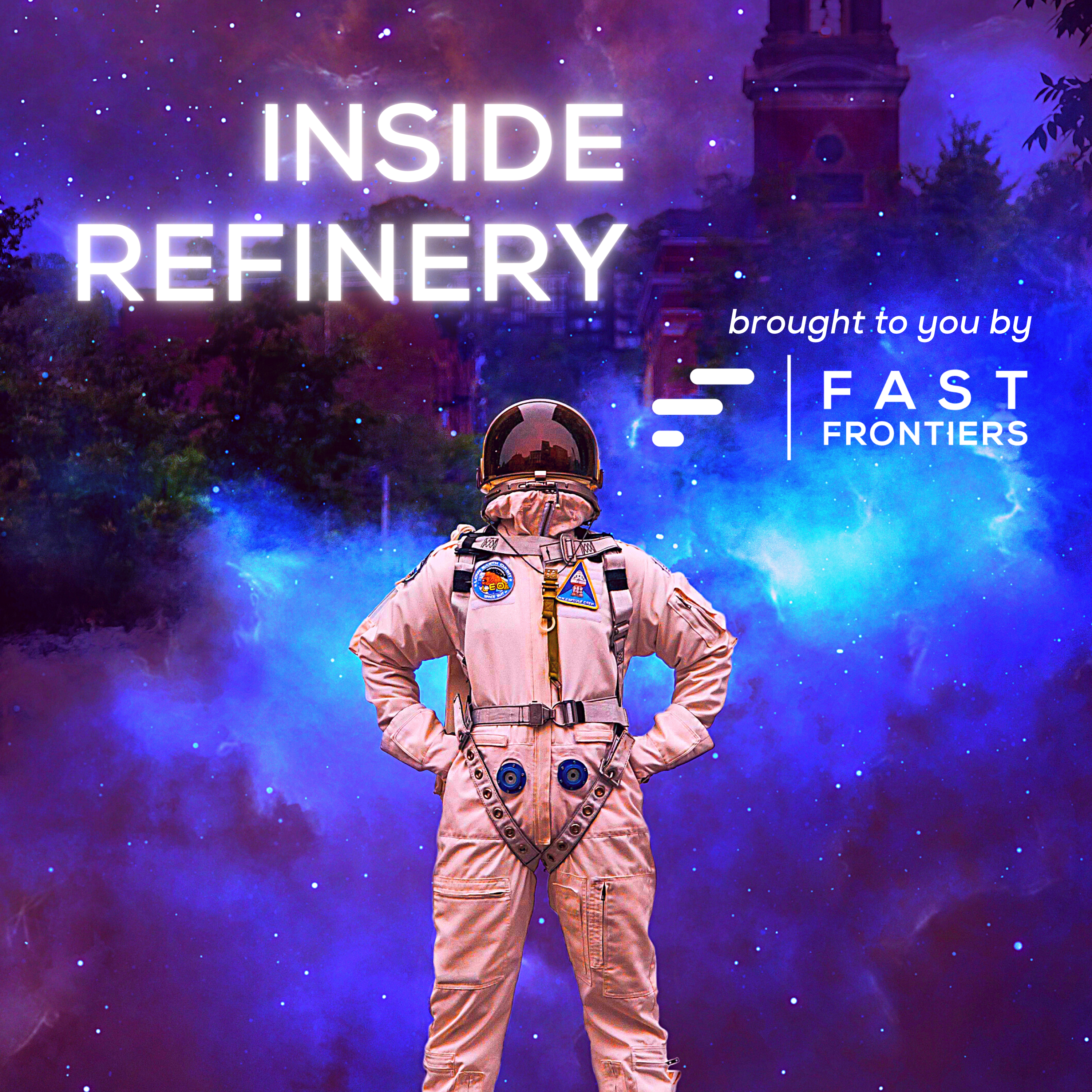S3 Ep 3. Ethan Batraski: Venrock
- 0.5
- 1
- 1.25
- 1.5
- 1.75
- 2
Tim Schigel: Welcome to Fast Frontiers. I am your host, Tim Schigel, managing partner of Refinery Ventures. In today's episode, we're talking with Ethan Batraski, partner of Venrock, in Palo Alto, California. Ethan invested across sectors with a particular focus on hard engineering problems, such as development infrastructure, advanced computing, and space technologies. Ethan has over 15 years experience as a founder and executive leader. Most recently, he held leadership roles at Facebook, leading the ads, product, and engineering efforts and overseeing a $15M run rate business. Prior to Facebook, he led product, growth, and design as VP of product and design at Box through their IPO. In this episode, we're going to dive into our shared investment in Astronomer and why they invested as well as the Space Frontier and how communication will change and new cases will start to emerge that we're not even thinking about today. The biggest theme or so what I hope you can take away from this conversation is the importance of being a great product leader. The product leader's responsibility is to make the problem very clear and then evangelize this to the rest of the organization. This creates empathy, answering the who, what, and why when you're solving a problem. It allows both product and engineering to feel closer to the customer. Please enjoy my conversation with Ethan Batraski.
Tim Schigel: Hello Ethan! Welcome to Fast Frontiers.
Ethan Batraski: Thank you for having me. I'm so excited to be here.
Tim Schigel: Great to have you on... As you know, we've developed this podcast, Fast Frontiers, for entrepreneurs, and particularly entrepreneurs in new frontiers that may be outside Silicon Valley and you're a Silicon Valley resident, VC, born and raised in the Bay Area, right? But you have a connection, you have a connection here to the Midwest. And more than one connection, because now we're connected in a joined investment, which is Astronomer.io. But tell us a little bit about your journey. You are a, I would say, kind of product guru extraordinaire.
Ethan Batraski: That's very sweet of you to say and check's in the mail, thanks for saying good things about me. I feel like I'm paying the big bucks. I've been in Venture for a little over four years now but before that, I studied 15 years as a founder and operator myself. I just started my undergrad as an astrophysics focus, thinking that I was going to go work at JPL and support their Perseverance mission. You know, this idea that we could push the boundaries of technology and unlock new capabilities, and the one that I was most interested in was becoming a multi-planet species and being able to push the boundaries of what was possible. And that came to a quick end when I dropped out of college to do my first start-up. And never went back. I ended up co-founding the start-up, we ended up getting acquired, I went to a few more start-ups either as the source employer or co-founder, and then I off-sided between large companies and back to startups mostly on the product and engineering side. I started as an engineer, moved over to product and design, and kind of went back and forth. I tried to bridge the law side and right side of my brains and most recently before I came to Venrock I had actually co-founded a seed fund that focused on technical founders solving technical problems sold to technical buyers. And when we came together, it was actually ten of us, we were all ex founders, we were all active operators at the time, wanting to design and build a Venture process the way we wished we had it when we were first raising money. In a way that investors understood and realized that founding teams are naturally incomplete, that there's naturally going to be an asymmetry in information, and that we want to almost bear hug the founders with complementary skills and capabilities and access to help them be successful and help them basically show them the gap from where they were to get the product-market fit at their scale. And that was a awesome time because it allowed us to take what we did best which was building companies and match that with founders that had crosstalk like-minded focuses. What got me there was I'd previously been at Facebook, I led product and engineering for a bit, it was a 15 billion dollar business, and before that had been at Box as VP of product and design through IPO. And before that, we sold our company. So we had seen what it took to go from zero to one million AR, ten million AR, to a hundred million of AR to 250 million of AR and what were the different requirements in terms of people and culture and focus. So we wanted to bring back to Venture and that led me to here at Venrock, where I've been for four years now.
Tim Schigel: Fascinating. So, back to the beginning, the early start-ups. What were the hard lessons you learned, mistakes that you made that you carried with you to the seed fund, for example?
Ethan Batraski: I don't think we probably have enough time to go through the list, but if I were to focus on just the top few, I think the biggest recurrent problem we see with companies at a very early stage are, one, there's a lack of clarity around the singular problem that they're going after. That was the one problem that you're in love with that you know it's a big, painful problem where there's not an obvious solution that if you can solve this problem in an elegant, meaningful, effective way, that the market will take as much as you could possibly offer.
Tim Schigel: Then would it be fair to say that, too often, entrepreneurs focus more on the solution than the problem?
Ethan Batraski: Absolutely. And it's natural to fall in love with the solution because you're excited about the construction and the art and the science of how it came together in order to solve this problem. But what then happens is you eventually lose sight of that problem and then the scope of that solution ends up drifting. And as you drift, the effectiveness or the application of that solution to the problem starts to be less and less crosstalk obvious or apparent.
Tim Schigel: Yeah, if the product is your North Star, not the customer, then you're going to go off course.
Ethan Batraski: Right. Right. It's hard at the early stages when you're going through the idea phase, but it's important that you just singularly focus on, "Here's a problem we're solving. Here's a problem we're solving. Here's..
Tim Schigel: Yep.
Ethan Batraski: The thing we care about. That promise has to be very customer-centric, to who you're solving it for. The second problem is always about market, not really understanding the market you're going into. And not, in many cases, being an expert in that market. Who are the other players? What are the dynamics? What are the driving factors that are changing that market that give you, a new company, an opportunity to enter and take advantage of a daily trend.
Tim Schigel: Right. People aren't successful because they just stumbled into that, that comes from some keen insights about the market that others don't have or can't buy in some report.
Ethan Batraski: If I see another McKinsey report on inaudible of the market, it makes me want to close my laptop because you really have to think about it in a more bottoms-up way that looks at the market differently than a cost scale report. And then three, I think the big fuss is just about having the right people at the start. It's easy to want to pull in your friends to work in your company with you, it's easy to want to find someone that is also thinking about building a company and you come together and then you'll find an idea. Building a long- term, thriving company is really based on, back to that number one, falling in love with some problem and then getting together with people who also share that deep love and understanding of that problem, and intrinsically intuitively know how to go about it in order to get to the root of it. And so often you see founders interested in a space because there's an interesting problem set that draws them into it, but they don't necessarily come from that space. And so they might have first and second-degree understanding, but when it comes to the third or fourth degree of detail and the nuances, they just don't have it and it causes them to trip up and it causes them to create a bunch of churn in the early days to try and get the product more fit. And in those early days it's like a rocket on the launchpad. A one-degree change in trajectory is a hundred million miles once you're in space.
Tim Schigel: Mm- hmm(affirmative).
Ethan Batraski: And so getting that right is critical.
Tim Schigel: So do you recall, just to put some flesh on this, back to your early start-up learnings, a specific instance that you can share that helped you learn one of those three problems or challenges?
Ethan Batraski: Yeah, I remember my very first company, we were building autonomous avatars in the virtual world of Second Life. You remember Second Life?
Tim Schigel: Yeah.
Ethan Batraski: 2005, 2006. It was blowing up. People would spend 12 to 14 hours a day in a virtual world, engaging with others and it was one of the very early examples of internet anonymity. Being able to be whoever you want to be, this idea of the internet archetype. The problem we're usually going after was that there was a virtual currency exchange happening within Second Life. And people were making real money selling virtual goods. Whether it's scarcity around housing, you could build a virtual house or you can buy a virtual product, like clothing and so on. And these virtual stores, had to have these avatars, these humans really just manning their stores in order to manage their transactions. And so we felt like, well, there's a way to remove the human from the loop and make this a little bit more like e-commerce but have it still feel like you're interacting with a real person through the transaction. To maintain the feeling of the virtual world, of the parallels to the real world. And we had built up a bit of prototypes. And what we realized early on was, and only looking back we realize, is that, how many stores could there possibly be in a virtual world? How many people really want to shift to an autonomous avatar? How big could this market get? If we had 100% penetration of every shop within a virtual world, not just Second Life but the long list of them that are merging at the time.
Tim Schigel: Right.
Ethan Batraski: Could this be a billion-dollar business? And I think we later realized, no, but we were so in love with what we were building that we totally lost sight of the market, the growth potential, and whether this problem was really that painful that was worthy to pay big dollars for. It ended up that it wasn't and the market wasn't big enough and it wasn't painful enough and we ended up pivoting to building a kind of contextual advertising engine based on the underlying technology which was based on the kind of early NLP and semantics. Early in the days when Google was just experimenting with AdSense and looking at the adeptness of a website in order to determine what the right ads were going to be. And that was a hard lesson because we realized that the path we were going down wasn't a viable long-term path. And the people that we had around the table for this new path weren't the right people. We had people on the table that are artists and understood human emotion as it relates to HMI. And those were not the right people in order to go build the actual advertising product. And so that was a hard pivot and a hard lesson that I continue to think back to this day, because there are so many nuances and how we thought about the decision and how we came to it that we could've avoided, had we had a better mental model going into it. But again, I was in my very, very early twenties and so it was really, at the time, about the fun, and not realizing the implications of that.
Tim Schigel: Important education nonetheless. I mean, the most important lessons are the ones that you learn by beating your head against the wall or faceplant and doing something wrong because you don't repeat it. So, when you think about your time at Box and at Facebook and in terms of leading product as a product leader, how would you describe your style or your unique take on that?
Ethan Batraski: To me, I always thought about product and a product leader as someone who deeply understood and owned the problem of what we were trying to solve and the outcome. Meaning the measurable outcome that we wanted to drive as a result of solving that problem. And always believe that the product leader's responsibility was to make the problem very clear, very finite, and then evangelize to why this problem is the one worth solving. Because ultimately, a product leader's job is to help set the North Star, prioritize, and make the trade-offs because we know that we have limited resources and limited time. And ultimately it's about driving the biggest businesses outcome and business impact and solving important, interesting problems for our customers. And so by focusing on the one, two, or three core problems and then attaching the simple metrics that we want to move, both the metric and the value that we want to get to, allows for a level of clarity amongst organizations to then double click on there. Say, "Okay, well if this is the problem, here's how I deconstruct it and here's how I measure how I'm going to then move those to the next level of those metrics." And I've always deployed a method I always called the Cascade Method, which is kind of an OKR- meets- product- roadmap that allows you to understand how a single problem could turn into a pretty different large apex and then convert into a number of use cases that the team can really focus on and show there's never orphan focus and orphan features. And by being this very problem focused centric product organization and engineering organization, want to create empathy to who we're solving, what we're solving, why we're solving it for them. And allow the product and engineering to feel closer. And so it disambiguates why we're doing something and what is we definitely should've done. Because it doesn't solve a problem then when we shouldn't be doing it in the way that we're doing it.
Tim Schigel: And it sounds like you also took care to make the connections between the product and the outcome, right? Back to not having orphan features. I've seen situations where the developers or anybody else inside the company who might be involved in the production of a product is not directly connected to the customer, right? It's one thing with Facebook where maybe everybody's a user as well, but when you're developing a product and you're not necessarily the user, you have to get creative, right? How do you develop that empathy?
Ethan Batraski: Yeah and even at Facebook, Facebook has 2000 teams, and if you're working on ads or in groups or events or... You're not always necessarily been a direct customer as well and it's all about either allowing engineering and other teams to access the customers and be able to talk to them, feel it and see it and about sharing as much as we understand about the market and the customers and the problems and where it's going. And how this connects to also the broader vision and narrative, right? It's all about we know that in 24 months from today, this is what the experience we want to be. This is what we want customers to be able to say about what we've built. And having those bookends, where we are today and where we want to be in 24 months is critical. Because then you know how to work backwards from there. And you can deconstruct the problems that are likely to emerge as a result and the next set of problem that then we need to solve and sequencing it is right. And so, as an engineer, if I know both where this is going to lead to in 24 months and how this is going to end, but also where this is going to go in three months and how that is connected. I both have a deeper connection to the problem itself and why we're doing it, and the why is so critical, the why is so much more important than the how and the what, but also can make better engineering decisions about how I architect this, what the data model structure should be, what the data flow should be over time, and I avoid a lot of the tech debt that piles up with teams that don't create the framing around where this is going and how this is sequenced to get there.
Tim Schigel: So glad you shared that because this is real gold for listeners who haven't been through this and understand it because I think people do make the mistake that they're so eager to counter produce and develop something and it takes discipline and creativity to develop that empathy you're talking about. And you actually have to slow down to do that, so the people do have the why and they have the context to then be way more effective. But too few people actually have the discipline to do that from what I've seen in my experience.
Ethan Batraski: Totally right.
Tim Schigel: So, we should probably touch on this and then we'll get to some of the other things you're doing, but you and I connected because of the investment in Astronomer.
Ethan Batraski: Mm- hmm(affirmative).
Tim Schigel: Started here in Cincinnati. Can you share why you invested in Astronomer? And describe what it is for listeners.
Ethan Batraski: So Astronomer are the commercial developers of Apache Airflow. Apache Airflow is a project that came out of Airbnb in 2015 that turns native pipelines into code. And as we know, every company today is becoming a data company. And being a data company means that you need to be able to have access to data at high velocities in order to leverage that data to make important business decisions. And the increased velocity and access to that data means that you have a faster integration to make those decisions but also access to data that otherwise didn't have access to before. If you take a step back, we've had this thesis around that moved to everything is code paradigm. Think about the 1990s, we saw the introduction of the GUI application. Then that led to the 2000s when we saw the introduction of a hosted app and a web app. The 2010s we saw the introduction of the cloud and services and that was really a reinvention at the application and platform layer, right? Hardware was moved into software as we saw with CloudFlare. And we really think 2020s will be about this emergence of the programmatic infrastructure, where we've done such an amazing job at applying code at the application layer to make things expressive and about end states and end goals. But we haven't done that at the infrastructure layer. And the infrastructure layer at this point, it still looks like in 2005. It's config files and scripts, it's brittle, it doesn't self-heal, it doesn't horizontally scale. And so we think there's a new generation of companies that are the equivalent of what Snowflake did by taking the data warehouse and just moving it to the cloud, where they're moving kind of each layer and structure into code. One big area focus for us has really been around Opensource. Particularly at the infrastructure layer and that's how we discovered in that the Astronomer team. When it comes to how we deliver and manage software, we still rely, as I mentioned, on these kind of manual brittle scripts to provision, deploy, configure, maintain, build. Whether it's a server, a cluster, an environment, a pipeline. And what we saw was that these efforts required teams of dev ops that constantly operate, maintain and triage in order to keep the infrastructure running. Because how we build software is something like how we build infrastructure. When we saw what Astronomer and Airflow were doing, we were just blown away. One, Airflow became one of the most popular libraries in the world, has 1000+ contributors, over 10,000 commits, I think now 20,000 stars, four million plus downloads. And what we saw was an amazing team to come together that included Bill, the original project maintainer, top contributors, and enterprise veterans to build the enterprise version of Airflow and eventually moved the entire data infrastructure into code. Because we know Opensource is built by the community, for the community. Which means it's not naturally enterprise-ready. It's not inaudible it doesn't plug into all the integrations, doesn't have the necessary security, doesn't scale. So Astronomer came together to replace the need for teams of dev ops to manage and triage these hundreds of data pipelines and turn it into a programmatic service that would auto-remediate, self-heal, scale, kind of just extract the whole complexity of the data pipeline. And Airflow today is the king of the data pipeline. And it's established by tens of thousands of companies and every modern data stack, every modern company you know is most likely on and rendering Airflow. And that means on or will likely run Astronomer.
Tim Schigel: Yeah it's amazing. And our friend Joe Otto, the CEO. Actually, Joe and I met when he was head of revenue for Greenplum and I was doing ShareThis and he tried to sell me Greenplum but ShareThis was one of the first AWS cloud customers. And so Greenplum was the previous generation business intelligence.
Ethan Batraski: Mm- hmm( affirmative). Mm- hmm(affirmative).
Tim Schigel: That was not cloud-native. So it's interesting how this stuff comes around, right?
Ethan Batraski: It's totally circular.
Tim Schigel: Yeah. It's amazing. So what are the interesting things, speaking of Fast Frontiers, is also something that I'm really proud of in the team is is that Astronomer was both open source and this commercialization team in the company is here in Cincinnati. So talk about kind of what's happening, the macro trends in terms of... And that's really unique because it's here it's an infrastructure company. It's not a FinTech app or some other business app, it's a core infrastructure company that's headquartered here and now has offices in many locations. But talk about what you see in terms of the trends investing outside Silicon Valley.
Ethan Batraski: Yeah, I've been a huge component of investing in companies outside Silicon Valley and starting companies outside Silicon Valley. You know it's funny, the running joke was that in 2010 a VC would say, "If you're not in San Francisco, you're not in tech." And come Covid in 2020 and everyone is saying, "Well, you're in San Francisco? No, no, no, you got to get the heck out. There's no engineers here anymore, they're dispersed everywhere else." You know I think since 2015 we've been saying that we have to diversify because Silicon Valley, while an amazing hub for talented creativity, has matured enough that it's enough offspring that you're starting to see a lot of percolating networks across the country and across the world that are really emerging really interesting companies and drawing really interesting talent. And with Covid, that trend, I think, accelerated by five years in just a few months. Because we now realize that the forcing function of having to work at home, every company can operate as a remote company. And every company can operate that way in probably a more effective, efficient, and successful way. They can scale faster, they can hire anywhere in the US, no longer having to hire just necessarily in limited geographies. They can go up to the best people, and in many cases those people have higher quality of life. They can go to places with low cost of living, and are excited about what the opportunity they get to do. And so this is how it should be. Technology is all about being able to move at the speed of light and break down barriers and, I think, being able to set up shop anywhere in the world should be the way. It's just becoming a really exciting time because if you're a founder you can go set up shop and build or hire the best talent from anywhere in the US or the world and you're able to get better talent that's happy and that'll stay with you longer. That seems like a no-brainer.
Tim Schigel: That's an amazing opportunity for entrepreneurs who wonder whether they can raise capital that the capital will travel now. When I was first in Venture we said Silicon Valley VCs not only wouldn't get on the plane, but I remember talking to some partners who determined their portfolio by whether the company was within a 20-minute drive of their office. They wouldn't go from San Francisco to the Peninsula or vice versa. Those days are gone.
Ethan Batraski: It's crazy. Yeah, I mean we have companies in Vancouver, one in Maine, multiple in LA, upstate New York, you name it. There's not a region in the US that we don't have a company and it's no longer an eliminating factor. I'm happy to get on a plane and go spend time with founders. Now in the days of Zoom, there's no rush to have to make it from San Francisco to drive down to Palo Alto to our office for a first pitch or to fly in for a first pitch. Let's just jump on Zoom, let's get to know each other, and as vaccinations roll out and travel will become more open like becomes more an obvious thing around the third or fourth meeting to then fly over and spend some time together.
Tim Schigel: Yeah, and you led the Series A investment in Astronomer in May of 2020. And that was interesting because Joe and I remember talking about it because we had a board meeting, I think in February, and talked about raising that round in second quarter. And then the Covid pandemic started and some thought, "Oh, we're going to have to wait 18 months." This and that. And have all the growth, I mean the metrics are there, right?
Ethan Batraski: Yeah. Yeah.
Tim Schigel: So it was great to bring it on board but that was an early investment during Covid when you couldn't meet in person.
Ethan Batraski: Yeah. I was going to get on a plane two weeks before. I remember, on March 15th I was going to go and spend some time with Joe and see him in person and then Covid travel advisories hit and we just continued to pursue it forward and we got the deal done at the end of March. During peak uncertainty of what was going to happen with Covid. I mean, I think at the time we were all joking like, "Are we going to be back in the office on April 10th? Or April 12th?"
Tim Schigel: Yeah.
Ethan Batraski: Telling Joe that, "I'll fly up to you in a few weeks. It'll be sometime in April, no problem." Uh, and still, to this day, we've still not met in person, which is crazy, but I think, looking back if we went into it thinking, "Can a remote-only deal work? Can we make investments from remote only? Not ever meeting the people?" Looking back and say unequivocally yes. The experiment was a success. I mean, it requires a bit more time and effort in terms of the amount of time you spend on Zoom and phone calls, it requires a bit more casual phone calls and conversations. Because for every one hour you spend together in person, you need like three or four hours on Zoom, just to understand the body language and the non-verbal communication. And just to build the relationship, because so much about this is about the human capital and the relationship between the founders and the leadership team. And that's so much more important than just metrics itself.
Tim Schigel: Yeah, you have to be deliberate about it. So, you've come full circle. So when you started out, you wanted to go work at JPL, incredible career as leading product at Box and Facebook and others. And now you're at Venrock four years and you're making space investments. The next big frontier. How does that feel?
Ethan Batraski: It's great. I mean, I love it. I'm so fortunate to be at Venrock and I'm so grateful to be able to do this for a living and being able to support amazing founders and building amazing thriving companies and solving really interesting problems. And so much of my focus has been on hard engineering problems and I tend to be very market-centric around where the markets that are shifting or changing or whether they're meaningful, as we talked about before, problems that aren't being addressed yet and what are their technologies that can enable that and enable to build businesses? So I focus as inaudible one is this kind of cloud infrastructure developer tool, trying to be open-sourced, bottoms-up. But the other one is put on frontier emerging technologies. These are particularly around technology approaches and breakthroughs that support new category creation. And most of them, particularly ones that have dual-use with defense applications. So where scientific discovery, risk is low, they become tractable engineering problems and they can be offered as a full-stack solution. So they don't sell in to supply chain, it's not a widget, it's an end-to-end system or solution. And most importantly, they're really founded by world-class teams. So there's been two areas we've been focused on. One is space and the other one is quantum. Both where there are technology breakthroughs that enable you to build new type of companies that couldn't have been built before. And so while space and quantum can be challenging, they have long validation cycles, they can be highly capital intensive. We believe that there are inflection points happening in this area where you can build big companies that can cover real solutions to the market. In the near terms that are much more capital efficient. And so we've made a number of other investments on the space side, one on the launch side and the other one on the spacecraft side, typically building microsatellites in GEO. And they've really been in this kind of think different category of going after highly established markets with players in a highly differentiated way.
Tim Schigel: Because they're kind of starting building kind of the native new system, new infrastructure?
Ethan Batraski: Exactly. And you're able to see what attempts have brought them to that point. Even when SpaceX launched the Falcon One and went to the Falcon Nine. There are a number of private companies that attempted to build a launch at that point. I mean, countless. SpaceX came to the world and say, "We are going to take a very different approach. We're going to be vertically integrated. We're going to build as much of that as possible in-house." And that's what allowed them to not only move faster but have faster innovations. And we've taken a lot of those learnings as we thought about the launch companies as, you know we know there are many. And on a spacecraft side, we think about it as kind of the bookends of the space economy today. You know? Spacecrafts that enable communications, which is $150 billion business. And then the launch, which is really about opening up access to space and we know that if we're going to have a trillion-dollar space economy one day, launch has to open up in order for that to be possible. And so we're really focused on both bookends.
Tim Schigel: What is that rough timeframe, you think?
Ethan Batraski: Good question. So, the challenges today, we have more launch demand, more spacecrafts that want to go into orbit than have space capacity, globally. And that means that you have to have access dedicated launch, that needs to be available, responsible, reliable. It has to be cheap. Today, the cheapest is 10k per kilogram. Based per space venture. That needs to get down to$1, 000 per kilogram or$ 500 per kilogram. And I think we're probably seven to 12 years away from that. I think we'll just continue to see the cost cart of launch go down and that is going to open up a massive opportunity for more and more companies to put spacecrafts into orbit and showcase the capabilities that we haven't been able to showcase today. That's going to be one key area. I think the second is that we're going to see the emergence of the new end-to-end satellite architecture. I think it's going to be based on microsatellites. You're not going to see these huge satellites in orbit anymore either in low orbit or MEO or GEO or even deep space. You're going to see microsatellites, smaller packages dominate in capability and cost and responsiveness compared to large legacy satellites. And then that will eventually lead to a new architecture that will become more standardized. You'll have standardized buses, competent interfaces, and that will eventually then drag down the cost through mass manufacturing. And eventually, allow to what I would call transformant in-orbit capabilities. Today, you build a 50 or 500 million or billion-dollar spacecraft, you put it out into orbit, that's the last time you're touching it.
Tim Schigel: Mm- hmm(affirmative).
Ethan Batraski: Now something goes wrong, you are effed.
Tim Schigel: Mm- hmm(affirmative).
Ethan Batraski: But imagine being able to do an in-orbit spacecraft upgrade. Or repair, or refuel, or expand it, or maneuver it. That dramatically changes the asset itself. And so if you think about the server market in the 70s to today as the evolution, we went from having to build my own server and host it in my own data center to taking my own server, putting it in someone else's data center, to eventually buying someone else's server and then eventually getting it into the cloud. And we're in that transition from first phase to second phase. I'm getting from the building everything myself to I get to buy others and then someone else will host it or launch it for me to eventually where I can just virtualize a piece or components as I need. And eventually you want to get to a point where if you want to enable some sort of super low-level NC communications network or you want something to enable for earth observation, you shouldn't have to launch your own spacecraft. You should be able to access that data where you need it when you need it to a virtualize mean. So I think we're slowly getting there. The building's much to coming together but it's slow.
Tim Schigel: Yeah, so seven to 12 years isn't too far but that's 10 to 20 reduction in cost of launch. And what, for the average user who's not a space investor, what's the world going to look like? What does that mean in terms of those services? Because you talked about dual-use, right? Government as well as private. So what do you think that world looks like?
Ethan Batraski: Yeah, so I think on the defense side, so I'll talk about two ways, on the defense side I think we're seeing a shift that's happening within our defense priorities that are moving away from bombs and bullets and anti-terrorist activities in the Middle East to this geopolitical war and arms race with China, where space is a particular focus. And it's a new domain that, in some cases, we're not on the forefront. You see with the emergence of Space Force that we need to expand beyond just major primes to satisfy inaudible needs and resiliency. We can't just depend on inaudible and keep it going. And so we're starting to see already more funding go into the admission from a commercial sector, more of the commercial sector going into defense. Which means that we're going to see, on the defense side, a just aggregation of the large space assets that we have today that are very vulnerable that, one, surface to orbit missile that we've seen from China and India and Russia, that they have those capabilities, can take out an entire major communications network, or our neutral capabilities, for example. That's a huge problem. Versus being able to just aggregate that and say, "Well, we're going to have a consolation of hundreds of satellites that are all redundant and all providing super low-laying NC communications that allow for better resiliency but better responsiveness. Which means that if one gets knocked out of orbit or if there's a problem with it I can just quickly launch another one. Which means both it needs to be cheap and easy to launch another one, and it has to be small enough and compact enough that I could just deploy from anywhere I need in the world and not have to spend four months shipping gifts and then get up its arm. And so I think that we're going to see, as a result of defense spending, more launch capabilities that are going to be focused on resiliency, they're going to be focused on being able to launch from off-scale locations on a moment's notice, that won't necessarily be based on you going to SpaceX launching game but eventually they should be able to do it on their own. It should be a product and a platform, not service. We're going to see a constellation of both communication in earth orbit, satellites that give the military the responsiveness and capability they need that they're missing today. So that's in the defense side. Then there's the exploration side, and then there's the commercial side. So on the exploration side we're seeing NASA's renewed focus on human space flight to the moon and Mars. We're seeing a significant amount of funding going into doing technologies to understand how do we graze the land, like for example, when we're going to go to Mars. How do we leverage the land in order to generate power? Like how do you extract key research in order to create fuel, and extract water? How do we leverage low power nuclear, how do we get to megawatt cost power, high-efficiency propulsion? So we're going to see, I think, a sharp acceleration of that focus there. Many things about NASA and to what SpaceX is doing. With the focus on Mars colonization. And then third, on the commercial side, in 10 years from now, every piece of communication should not have to be based on the terrestrial network anymore. We know that the way we connected the first four billion that are online today will not be the way we connect the next three billion people that are planning to come online over the next 10 years. Because of lands too far, regions too remote, climates too extreme, terrestrial ways of laying fiber in order to create self-power networks in order to create connectivity. It just won't work. And so we know that that's going to have to be connected through a space network. And so every piece of communication, whether it's your cellphone, how we connect to the internet, how we access information around what's going on around us in a real-time way, we'll be able to be enabled through orbit constellations that would just allow us to get more data faster in a cheaper way that will then probably emerge a new set of industries that we're not even thinking about today. Like if I have a camera that has Persistence over every single street section in a given city, could I use that in a more real-time way to do traffic management and traffic orchestration? Probably. Because today with that challenges I don't have that data. And it's too hard to consolidate it and so on. But if I can get by in real-time, I can do mass traffic orchestration and literally eradicate traffic. Altogether. Because it's a network problem, it's not a congestion problem. And so, imagine just new cases like that that start to emerge that we're not even thinking about or able to do today.
Tim Schigel : Yeah that's pretty exciting. Obviously, the cost will be driven down, we'll have many, many different choices and different platforms, almost like the proliferation of social networks, right? Different types of data networks that are all interconnected in the great... So, Ethan, this has been terrific. It's never boring when you and I get together and talk, that's for sure. And I feel like there's so much more we can go into. But it's incredible to see how your career's kind of come full-circle and the exciting things you're doing. Really appreciate you and appreciate you sharing your time with Fast Frontiers.
Ethan Batraski: Well, I really enjoyed the conversation and I really appreciate you having me, so. Look forward to doing it again.
Tim Schigel: Thanks.
Tim Schigel: Thanks for listening to Fast Frontiers. If you like our show and want to know more, check out our website FastFrontiers.com. If you enjoyed this episode please share with others and leave us a review on your favorite podcast platform. Again, in this first week of Fast Frontiers season three, we have three great conversations to share. You can listen to them all right now. Join us next week when we bring you our first duo episode, conversation with Nick Cromydas of Hunt Club and Kaleb Dumont of Integrity Power Search. The Fast Frontiers podcast is brought to you by Refinery Ventures, our producer is Abby Fttes, audio engineering by Astronomic Audio, marketing, content and social media support from Content Callout, and our podcast platform is Casted.
DESCRIPTION
In today's episode, we're talking with Ethan Batraski, Partner at Venrock, in Palo Alto, California. We're going to dive into our shared investment in Astronomer and why they invested as well as the Space Frontier and how communication will change and new cases will start to emerge that we're not even thinking about today.
Please click on any related resources below for more information about what we discuss in this episode.
Today's Host

Tim Schigel
Today's Guests








